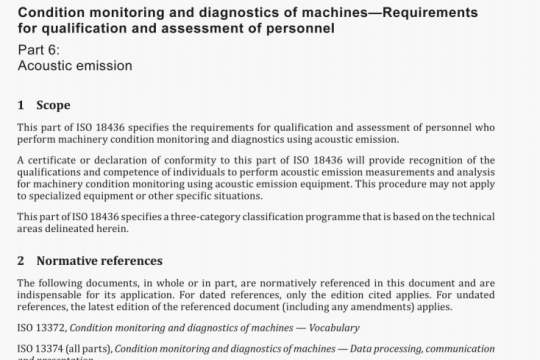BS ISO 7404-4:2017 pdf free
BS ISO 7404-4:2017 pdf free.Methods for the petrographic analysis of coals
Examination by using a reflected light microscope and point count procedure of a representative sample of coal prepared as a particulate block as described in ISO 7404-2. Identification under an immersion medium of the microlithotypes from their maceral composition. The proportions of the macerals are determined using a graticule having a grid with 20 points of intersection spaced to define a distance of 50 um on the specimen between extreme intersections in the x (abscissa) and y (ordinate) directions,respectively. The use of such a graticule allows the analyst to comply with the 5 % minimum content and 50 μm minimum size stipulation.
Insert the graticule (6.2) into the eyepiece of the adjusted microscope (6.1).
Place the levelled particulate block, prepared in accordance with ISO 7404-2, on the stage. Add the immersion medium to the surface of the block, focus and observe the image in the microscope.
Assess the number of crossline intersections lying on the particle in order to decide whether the point should be recorded in the counting procedure and, if so, whether it should be assigned to the category of a microlithotype, carbominerite or minerite. If the number of intersections on one particle is 10 or more the point shall be accepted for analysis. If there are no intersections on coal or mineral matter, the point is ignored (i.e. it is not recorded). If the number is less than 10 it shall be recorded as a rejected category and the stage shall be advanced by one step. The number of such rejected points shall not exceed 10 % of the total accepted and rejected points. If the proportion exceeds 10 %, excessive fines may have been produced during preparation and a fresh sample should be prepared if material is available. If this is not possible the fact shall be recorded in the test report. For identifying the material under the individual crosslines, apply the procedure described in ISO 7404-3. The criteria for determining accepted and rejected points are shown in Figure 2.
If the particle is accepted for analysis, assess the number of intersections lying on mineral matter. If the number of crossline intersections on mineral matter exceeds the number shown in Table 1 for a given number of intersections lying within the particle, the material is either carbominerite or minerite.BS ISO 7404-4 pdf download.




